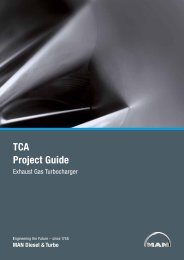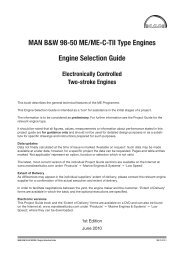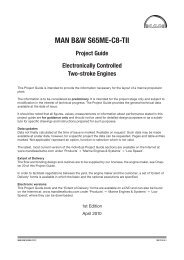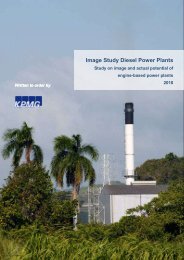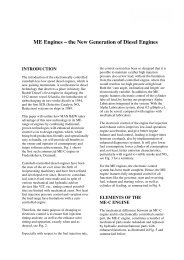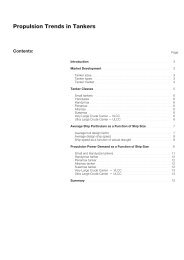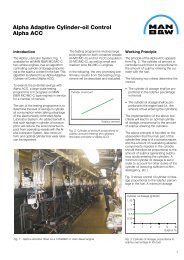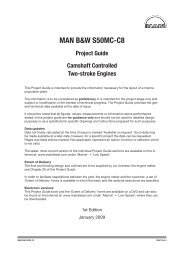This section is available on request - MAN Diesel & Turbo
This section is available on request - MAN Diesel & Turbo
This section is available on request - MAN Diesel & Turbo
Create successful ePaper yourself
Turn your PDF publications into a flip-book with our unique Google optimized e-Paper software.
<strong>MAN</strong> B&W 15.04<br />
Exhaust gas silencer<br />
The typical octave band sound pressure levels<br />
from the diesel engine’s exhaust gas system – at a<br />
d<str<strong>on</strong>g>is</str<strong>on</strong>g>tance of <strong>on</strong>e meter from the top of the exhaust<br />
gas uptake – are shown in Fig.15.04.0 .<br />
The need for an exhaust gas silencer can be decided<br />
based <strong>on</strong> the requirement of a maximum<br />
perm<str<strong>on</strong>g>is</str<strong>on</strong>g>sible no<str<strong>on</strong>g>is</str<strong>on</strong>g>e level at a specific positi<strong>on</strong>.<br />
The exhaust gas no<str<strong>on</strong>g>is</str<strong>on</strong>g>e data <str<strong>on</strong>g>is</str<strong>on</strong>g> valid for an exhaust<br />
gas system without boiler and silencer, etc.<br />
The no<str<strong>on</strong>g>is</str<strong>on</strong>g>e level <str<strong>on</strong>g>is</str<strong>on</strong>g> at nominal MCR at a d<str<strong>on</strong>g>is</str<strong>on</strong>g>tance of<br />
<strong>on</strong>e metre from the exhaust gas pipe outlet edge<br />
at an angle of 30° to the gas flow directi<strong>on</strong>.<br />
For each doubling of the d<str<strong>on</strong>g>is</str<strong>on</strong>g>tance, the no<str<strong>on</strong>g>is</str<strong>on</strong>g>e level<br />
will be reduced by about 6 dB (far�field law).<br />
When the no<str<strong>on</strong>g>is</str<strong>on</strong>g>e level at the exhaust gas outlet to<br />
the atmosphere needs to be silenced, a silencer<br />
can be placed in the exhaust gas piping system<br />
after the exhaust gas boiler.<br />
The exhaust gas silencer <str<strong>on</strong>g>is</str<strong>on</strong>g> usually of the absorpti<strong>on</strong><br />
type and <str<strong>on</strong>g>is</str<strong>on</strong>g> dimensi<strong>on</strong>ed for a gas velocity of<br />
approximately 35 m/s through the central tube of<br />
the silencer.<br />
An exhaust gas silencer can be designed based<br />
<strong>on</strong> the required damping of no<str<strong>on</strong>g>is</str<strong>on</strong>g>e from the exhaust<br />
gas given <strong>on</strong> the graph.<br />
In the event that an exhaust gas silencer <str<strong>on</strong>g>is</str<strong>on</strong>g> required<br />
– th<str<strong>on</strong>g>is</str<strong>on</strong>g> depends <strong>on</strong> the actual no<str<strong>on</strong>g>is</str<strong>on</strong>g>e level<br />
requirement <strong>on</strong> the bridge wing, which <str<strong>on</strong>g>is</str<strong>on</strong>g> normally<br />
maximum 60�70 dB(A) – a simple flow silencer of<br />
the absorpti<strong>on</strong> type <str<strong>on</strong>g>is</str<strong>on</strong>g> recommended. Depending<br />
<strong>on</strong> the manufacturer, th<str<strong>on</strong>g>is</str<strong>on</strong>g> type of silencer normally<br />
has a pressure loss of around 0 mm WC at<br />
specified MCR.<br />
Spark arrester<br />
Page of<br />
��������<br />
��������<br />
178 52 48-4.1<br />
Fig. 15.04.02: ISO’s NR curves and typical sound pressure<br />
levels from the engine’s exhaust gas system. The<br />
no<str<strong>on</strong>g>is</str<strong>on</strong>g>e levels at nominal MCR and a d<str<strong>on</strong>g>is</str<strong>on</strong>g>tance of 1 metre<br />
from the edge of the exhaust gas pipe opening at an angle<br />
of 30 degrees to the gas flow and valid for an exhaust<br />
gas system – without boiler and silencer, etc. Data for a<br />
specific engine and cylinder no. <str<strong>on</strong>g>is</str<strong>on</strong>g> <str<strong>on</strong>g>available</str<strong>on</strong>g> <strong>on</strong> <strong>request</strong>.<br />
To prevent sparks from the exhaust gas being<br />
spread over deck houses, a spark arrester can be<br />
fitted as the last comp<strong>on</strong>ent in the exhaust gas<br />
system.<br />
It should be noted that a spark arrester c<strong>on</strong>tributes<br />
with a c<strong>on</strong>siderable pressure drop, which <str<strong>on</strong>g>is</str<strong>on</strong>g><br />
often a d<str<strong>on</strong>g>is</str<strong>on</strong>g>advantage.<br />
It <str<strong>on</strong>g>is</str<strong>on</strong>g> recommended that the combined pressure<br />
loss across the silencer and/or spark arrester<br />
should not be allowed to exceed 100 mm WC at<br />
specified MCR. <str<strong>on</strong>g>Th<str<strong>on</strong>g>is</str<strong>on</strong>g></str<strong>on</strong>g> depends, of course, <strong>on</strong> the<br />
pressure loss in the remaining part of the system,<br />
thus if no exhaust gas boiler <str<strong>on</strong>g>is</str<strong>on</strong>g> installed, 00 mm<br />
WC might be allowed.<br />
<strong>MAN</strong> B&W S65ME-C/ME-GI8 198 49 12-3.1<br />
<strong>MAN</strong> <strong>Diesel</strong><br />
��<br />
���<br />
���<br />
���<br />
���<br />
��<br />
��<br />
��<br />
��<br />
�� �<br />
��<br />
��<br />
��<br />
��<br />
���� �� ��� ��� ��� �� �� �� ����<br />
��<br />
��<br />
���������������������������������<br />
���<br />
���<br />
���<br />
���<br />
��<br />
��<br />
�����<br />
������



